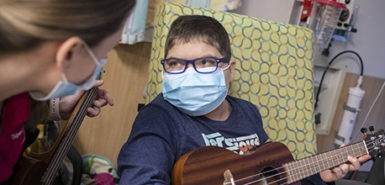
“It sounded like she was struggling to breathe, and if she got excited or worked up, it got worse,” Roy said.
Rubie, who was born in July 2014, also refused to eat large amounts and wasn’t putting on much weight. But what led Roy to call the doctor was the sound of Rubie’s breathing when she slept.
“She wouldn’t sleep for long, and it sounded like she had a lot of fluid in her lungs—it was definitely cause for concern,” Roy said.
When the pediatrician referred her to Spectrum Health Medical Group’s Ear, Nose & Throat practice, she learned her baby had been born with a condition called laryngomalacia. In lay terms, Rubie had a floppy larynx.
When she inhaled, a flap of tissue on her voice box would collapse and obstruct the airway. The result was the strained breathing known as stridor, which is the No. 1 symptom of laryngomalacia.
Stridor often appears at about 2 weeks of age, according to Andrew Heaford, MD, a pediatric otolaryngologist with Spectrum Health Medical Group Ear, Nose and Throat.
“During a baby’s first two to four months, the stridorous breathing will get worse, but most babies will outgrow it,” Dr. Heaford said. “Fifty percent grow out of it by 9 months, and 75 percent outgrow it by 18 months.”
Treatment for stridor
The goal of treatment is to help infants outgrow the condition. A few simple things can help keep babies comfortable and well fed so they can ride out this respiratory issue:
- Anti-reflux medication. In Dr. Heaford’s experience, stridor is almost always associated with gastroesophageal reflux, which can cause babies to spit up. Controlling the reflux makes it easier for babies to gain weight.
- Keeping babies upright during feedings and for 30 minutes after feeding.
- Increasing the angle of the crib to elevate the baby’s head.
For most patients, these strategies alleviate the symptoms so they can outgrow the underlying problems.
For Rubie, relief through surgery
In baby Rubie’s case, however, her reflux and respiratory distress were so severe that Dr. Heaford recommended a surgery called supraglottoplasty. In this procedure, the doctor trims away the folds restricting the airway, and the baby gets immediate relief.
Rubie’s surgery, at 3 months of age, achieved exactly what her mother was hoping for.
“It has made a world of difference,” she said. “Almost instantly after I brought her home, she was smiling and laughing so much more than before. She also started taking baby food, which she didn’t do before.”
Today, at 7 months, Rubie is a happy baby who sleeps through the night and is “climbing up the growth charts,” Dr. Heaford said.
Laryngomalacia is a fairly uncommon condition, but parents need to be aware of it because it can pop up quickly and the best way to avoid surgery and complications is to catch it early. Only about 15 percent of the laryngomalacia patients Dr. Heaford sees don’t respond well to treatment, making them candidates for the supraglottoplasty.
“Even though it’s very nerve-racking to send your baby into surgery, I felt very confident in Dr. Heaford’s abilities,” Roy said. “And as soon as she got out of surgery they put her right in my arms so I could hold her again.”
To learn more about laryngomalacia and stridor, view an interview with Chad Afman, MD, a pediatric otolaryngologist with Spectrum Health Medical Group, in the Fox 17 Medical Moment “Noisy breathing problems in children.”
 /a>
/a>
 /a>
/a>
 /a>
/a>